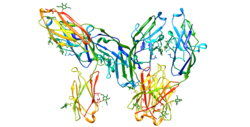| CD33 | |||||||||||||||||||||||||||||||||||||||||||||||||||
|---|---|---|---|---|---|---|---|---|---|---|---|---|---|---|---|---|---|---|---|---|---|---|---|---|---|---|---|---|---|---|---|---|---|---|---|---|---|---|---|---|---|---|---|---|---|---|---|---|---|---|---|
 | |||||||||||||||||||||||||||||||||||||||||||||||||||
| |||||||||||||||||||||||||||||||||||||||||||||||||||
| Identifiers | |||||||||||||||||||||||||||||||||||||||||||||||||||
| Aliases | CD33, CD33 molecule, SIGLEC-3, SIGLEC3, p67 | ||||||||||||||||||||||||||||||||||||||||||||||||||
| External IDs | OMIM: 159590 HomoloGene: 88651 GeneCards: CD33 | ||||||||||||||||||||||||||||||||||||||||||||||||||
| |||||||||||||||||||||||||||||||||||||||||||||||||||
| |||||||||||||||||||||||||||||||||||||||||||||||||||
| |||||||||||||||||||||||||||||||||||||||||||||||||||
| |||||||||||||||||||||||||||||||||||||||||||||||||||
| Wikidata | |||||||||||||||||||||||||||||||||||||||||||||||||||
| |||||||||||||||||||||||||||||||||||||||||||||||||||
CD33 or Siglec-3 (sialic acid binding Ig-like lectin 3, SIGLEC3, SIGLEC-3, gp67, p67) is a transmembrane receptor expressed on cells of myeloid lineage.[3] It is usually considered myeloid-specific, but it can also be found on some lymphoid cells.[4]
It binds sialic acids, therefore is a member of the SIGLEC family of lectins.
Structure[edit]
The extracellular portion of this receptor contains two immunoglobulin domains (one IgV and one IgC2 domain), placing CD33 within the immunoglobulin superfamily. The intracellular portion of CD33 contains immunoreceptor tyrosine-based inhibitory motifs (ITIMs) that are implicated in inhibition of cellular activity.[5]
Function[edit]
CD33 can be stimulated by any molecule with sialic acid residues such as glycoproteins or glycolipids. Upon binding, the immunoreceptor tyrosine-based inhibition motif (ITIM) of CD33, present on the cytosolic portion of the protein, is phosphorylated and acts as a docking site for Src homology 2 (SH2) domain-containing proteins like SHP phosphatases. This results in a cascade that inhibits phagocytosis in the cell.[6]
Alzheimer's disease[edit]
CD33 controls microglial activation but in Alzheimer disease it goes overdrive in presence of amyloid and tau proteins, its expression is known to be tied to TREM2.[7][8][9][10]
Clinical significance[edit]
CD33 is the target of gemtuzumab ozogamicin (trade name: Mylotarg®; Pfizer/Wyeth-Ayerst Laboratories),[11] an antibody-drug conjugate (ADC) for the treatment of patients with acute myeloid leukemia. The drug is a recombinant, humanized anti-CD33 monoclonal antibody (IgG4 κ antibody hP67.6) covalently attached to the cytotoxic antitumor antibiotic calicheamicin (N-acetyl-γ-calicheamicin) via a bifunctional linker (4-(4-acetylphenoxy)butanoic acid).[12] Several mechanisms of resistance to gemtuzumab ozogamicin have been elucidated.[13] On September 1, 2017, the FDA approved Pfizer's Mylotarg.[14]
Gemtuzumab ozogamicin was initially approved by the U.S. Food and Drug Administration in 2000. However, during post marketing clinical trials researchers noticed a greater number of deaths in the group of patients who received gemtuzumab ozogamicin compared with those receiving chemotherapy alone. Based on these results, Pfizer voluntarily withdrew gemtuzumab ozogamicin from the market in mid-2010, but was reintroduced to the market in 2017.[15][16][17]
CD33 is also the target in Vadastuximab talirine (SGN-CD33A), a novel antibody-drug conjugate being developed by Seattle Genetics, utilizing this company's ADC technology.[18]
References[edit]
- ^ a b c GRCh38: Ensembl release 89: ENSG00000105383 - Ensembl, May 2017
- ^ "Human PubMed Reference:". National Center for Biotechnology Information, U.S. National Library of Medicine.
- ^ Garnache-Ottou F, Chaperot L, Biichle S, Ferrand C, Remy-Martin JP, Deconinck E, et al. (February 2005). "Expression of the myeloid-associated marker CD33 is not an exclusive factor for leukemic plasmacytoid dendritic cells". Blood. 105 (3): 1256–1264. doi:10.1182/blood-2004-06-2416. PMID 15388576.
- ^ Hernández-Caselles T, Martínez-Esparza M, Pérez-Oliva AB, Quintanilla-Cecconi AM, García-Alonso A, Alvarez-López DM, García-Peñarrubia P (January 2006). "A study of CD33 (SIGLEC-3) antigen expression and function on activated human T and NK cells: two isoforms of CD33 are generated by alternative splicing". Journal of Leukocyte Biology. 79 (1): 46–58. doi:10.1189/jlb.0205096. PMID 16380601. S2CID 21259300.
- ^ Myeloid cell surface antigen CD33 precursor – Homo sapiens (Human)
- ^ Zhao L (2018-12-12). "CD33 in Alzheimer's Disease - Biology, Pathogenesis, and Therapeutics: A Mini-Review". Gerontology. 65 (4): 323–331. doi:10.1159/000492596. PMID 30541012.
- ^ Griciuc A, Patel S, Federico AN, Choi SH, Innes BJ, Oram MK, et al. (September 2019). "TREM2 Acts Downstream of CD33 in Modulating Microglial Pathology in Alzheimer's Disease". Neuron. 103 (5): 820–835.e7. doi:10.1016/j.neuron.2019.06.010. PMC 6728215. PMID 31301936.
- ^ Chan G, White CC, Winn PA, Cimpean M, Replogle JM, Glick LR, et al. (November 2015). "CD33 modulates TREM2: convergence of Alzheimer loci". Nature Neuroscience. 18 (11): 1556–1558. doi:10.1038/nn.4126. PMC 4682915. PMID 26414614.
- ^ "Deleting CD33 Benefits Mice—If Their Microglia Express TREM2". ALZFORUM. Retrieved 2022-02-17.
- ^ Stetka B (2022-01-30). "How a hyperactive cell in the brain might trigger Alzheimer's disease". NPR. Retrieved 2022-02-17.
- ^ Walter RB, Gooley TA, van der Velden VH, Loken MR, van Dongen JJ, Flowers DA, et al. (May 2007). "CD33 expression and P-glycoprotein-mediated drug efflux inversely correlate and predict clinical outcome in patients with acute myeloid leukemia treated with gemtuzumab ozogamicin monotherapy". Blood. 109 (10): 4168–4170. doi:10.1182/blood-2006-09-047399. PMC 1885511. PMID 17227830.
- ^ "Calicheamicin (LL-E33288 antibiotics)". ADC Review / Journal of Antibody-drug Conjugates. 20 March 2015.
- ^ Molica M, Perrone S, Mazzone C, Niscola P, Cesini L, Abruzzese E, de Fabritiis P (June 2021). "CD33 Expression and Gentuzumab Ozogamicin in Acute Myeloid Leukemia: Two Sides of the Same Coin". Cancers. 13 (13): 3214. doi:10.3390/cancers13133214. PMC 8268215. PMID 34203180.
- ^ "FDA approves Mylotarg for treatment of acute myeloid leukemia". Food and Drug Administration. 24 March 2020.
- ^ "Gemtuzumab ozogamicin (Mylotarg®) Drug Description". ADC Review / Journal of Antibody-drug Conjugates. 19 July 2015.
- ^ "Pfizer Voluntarily Withdraws Cancer Treatment Mylotarg from U.S. Market". FDA Press Release. 21 June 2010.
- ^ "FDA approves Mylotarg for treatment of acute myeloid leukemia". Food and Drug Administration. 24 March 2020.
- ^ "Vadastuximab Talirine (SGN CD33a) Drug Description". ADC Review / Journal of Antibody-drug Conjugates. 23 November 2015.
External links[edit]
- Human CD33 genome location and CD33 gene details page in the UCSC Genome Browser.

